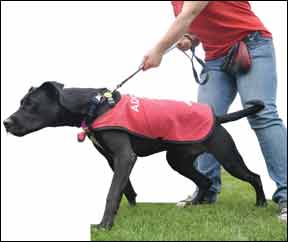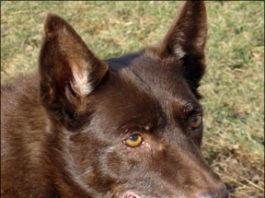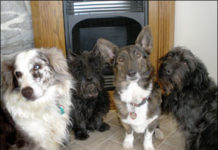How to Teach A Dog to “Leave It”
There are many times in your dog's life when she needs to be able to control her impulse to engage in a behavior. Last month, we discussed Wait" and "Stay" but impulse control goes far beyond these "don't move" cues. "Leave it" is another impulse-control behavior that is very useful for your dog to know. The cue means
Tail-Wagging Training
Training, says Massachusetts dog trainer Donna Duford, should be fun, not work. Her seminars are such upbeat, tail-wagging events that the dogs seem to be having a party. Look closer and you’ll see a serious class, with participants taking notes as Duford reviews the laws of learning and defines classical conditioning, operant conditioning, positive and negative reinforcement, positive and negative punishment, continuous and variable reinforcement schedules, and other fundamentals of behavioral training.
Training a Dog to Stay Using Cues
Sandi chooses a
quiet location. Blue is easily distracted, so
she works at a close range and slowly builds
the duration of the Stay.üWhen a cyclist pulled up, Sandi moved right
next to Blue to ascertain how he would deal
with a distraction.
quiet location. Blue is easily distracted, so
she works at a close range and slowly builds
the duration of the Stay.üWhen a cyclist pulled up, Sandi moved right
next to Blue to ascertain how he would deal
with a distraction.
New to Positive Dog Training?
Switching to positive training? At first, it might be frustrating for you – and your dog. The benefits, however, will last a lifetime. In positive training, the goal is to help the dog do the right thing and then reward him for it, rather than punishing him for doing the wrong thing. If he makes a mistake, the behavior is ignored, or excused with an “Oops, try again!” to encourage the dog to do something else.
Eye Contact in Dog Training
It's really not natural for dogs to offer direct and prolonged eye contact. In the dog world, direct eye contact is a threat, and the appropriate response to a direct stare is to look away as a deference or appeasement behavior (I'm not challenging you/please don't hurt me!"). In many human cultures
5 Professional Dog Training Tips
Yes, raising and training a puppy takes work, but it doesn't need to feel overwhelming at least, not the majority of the time! The more you know, the easier it gets. As I think about my own approach to raising and living with dogs, and that of many of my colleagues, I realize we engage in numerous behaviors that are extraordinarily helpful yet it's often difficult to get the pet owners we work for to try them! Don't resist! The following five tips can help you train like a pro.
Beware of the Poisoned Dog Cue
A cue becomes “poisoned” when the dog’s association with the cue is ambiguous – it’s sometimes associated with positive reinforcement, and sometimes associated with punishment. When the association is ambiguous, the dog becomes confused and doesn’t know what to expect. Poisoning your “Come!” cue is the best way to ensure that she’ll stop and weigh her choices, then take off after the bounding deer, rather than come galloping to you when you call.
Dog Trainers Note How Men and Women May Train Differently
Men are from Mars. Women are from Venus. Dogs are from Neptune. A well-known trainer recently made a public comment about men’s inability to act silly with their dogs, to the detriment of their ability to use positive training methods effectively. Are we really three alien species, destined to live forever in a world of miscommunication and misinterpretation? Is one gender truly better suited to bridge the communication gap between the human and canine species?
Debunking the Dog’s “Guilty Look” Myth
I just talked to a potential client who is interested in bringing his 7-month-old Golden Doodle to train with us at AutumnGold. His dog, Penny, has the usual young dog issues - jumping up, a bit of nipping during play, still the occasional slip in house training, etc. Penny also raids the kitchen garbage bin, removing and shredding food wrappers, napkins, and any other paper goodies that she can find. The owner tells me that he is particularly upset about this last behavior because he is certain that Penny knows she has done wrong". He knows this because . . . wait for it . . . "Penny always looks guilty when he confronts her after the dreaded act."""
Using Your Dog’s Bowl As a Training Tool
You may think feeding your dog is a simple matter of dumping food in his bowl and plopping it down on the floor in front of him. You may be wrong. Mealtime is fraught with significance for your dog, and loaded with opportunities for you to influence his health and his behavior. Failure to take advantage of these could actually contribute to the development and/or escalation of problems that might otherwise be averted. A few deliberate decisions and choices on your part can go far in creating harmony in your home.
The ABCs of Training
We have Edward Thorndike (1874 - 1949) to thank for teaching us about The Law of Effect. While studying behaviorism, he observed and described The Law of Effect, which states that behaviors change as a result of the consequences to actions. Boundless.com has a nice succinct explanation of The Law of Effect:
Consistent Dog Training With Regards to Men and Women
In general, men tend to be more physical with their dogs, and more assertive, enjoying rough-and-tumble wrestling games and expecting the dog to understand and obey. Women tend to be softer, more into cuddling than wrestling, and take more interest in teaching the dog to understand the complex world of primate (human) communication.











